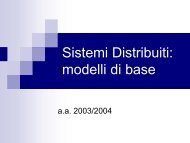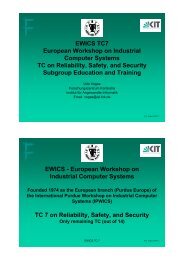Chapter 20: Multimedia Systems
Chapter 20: Multimedia Systems
Chapter 20: Multimedia Systems
Create successful ePaper yourself
Turn your PDF publications into a flip-book with our unique Google optimized e-Paper software.
<strong>Chapter</strong> <strong>20</strong>: <strong>Multimedia</strong><strong>Systems</strong>Operating System Concepts – 8 th Edition,Silberschatz, Galvin and Gagne ©<strong>20</strong>09
<strong>Chapter</strong> <strong>20</strong>: <strong>Multimedia</strong> <strong>Systems</strong>• What is <strong>Multimedia</strong>?• Compression• Requirements of <strong>Multimedia</strong> Kernels• CPU Scheduling• Disk Scheduling• Network Management• An Example: CineblitzOperating System Concepts – 8 th Edition<strong>20</strong>.2 Silberschatz, Galvin and Gagne ©<strong>20</strong>09
Objectives• To identify the characteristics of multimedia data• To examine several algorithms used to compress multimediadata• To explore the operating system requirements of multimediadata, including CPU and disk scheduling and networkmanagementOperating System Concepts – 8 th Edition<strong>20</strong>.3 Silberschatz, Galvin and Gagne ©<strong>20</strong>09
Media Delivery• <strong>Multimedia</strong> data is stored in the file system like other ordinary data• However, multimedia data must be accessed with specific timingrequirements• For example, video must be displayed at 24-30 frames per second.<strong>Multimedia</strong> video data must be delivered at a rate which guarantees 24-30frames/second• Continuous-media data is data with specific rate requirementsOperating System Concepts – 8 th Edition<strong>20</strong>.5 Silberschatz, Galvin and Gagne ©<strong>20</strong>09
Streaming• Streaming is delivering a multimedia file from a server to a client - typicallythe deliver occurs over a network connection• There are two different types of streaming:1. Progressive download - the client begins playback of the multimedia fileas it is delivered. The file is ultimately stored on the client computer2. Real-time streaming - the multimedia file is delivered to - but not storedon - the client’s computerOperating System Concepts – 8 th Edition<strong>20</strong>.6 Silberschatz, Galvin and Gagne ©<strong>20</strong>09
Real-time Streaming• There are two types of real-time streaming:(1) Live streaming - used to deliver a live event while it is occurring(2) On-demand streaming - used to deliver media streams such as movies,archived lectures, etc. The events are not delivered in real-timeOperating System Concepts – 8 th Edition<strong>20</strong>.7 Silberschatz, Galvin and Gagne ©<strong>20</strong>09
<strong>Multimedia</strong> <strong>Systems</strong> Characteristics• <strong>Multimedia</strong> files can be quite large• Continuous media data may require very high data rates• <strong>Multimedia</strong> applications may be sensitive to timing delays duringplayback of the mediaOperating System Concepts – 8 th Edition<strong>20</strong>.8 Silberschatz, Galvin and Gagne ©<strong>20</strong>09
Compression• Because of the size and rate requirements of multimedia systems,multimedia files are often compressed into a smaller form• MPEG Compression:(1) MPEG-1 - 352 X 240 @ 30 frames/second(2) MPEG-2 - Used for compressing DVD and high-definition television(HDTV)(3) MPEG-4 - Used to transmit audio, video, and graphics. Can be deliveredover very slow connections (56 Kbps)Operating System Concepts – 8 th Edition<strong>20</strong>.9 Silberschatz, Galvin and Gagne ©<strong>20</strong>09
Operating <strong>Systems</strong> Issues• The operating system must guarantee the specific data rate and timingrequirements of continuous media• Such requirements are known as Quality-of-Service (QoS) guaranteesOperating System Concepts – 8 th Edition<strong>20</strong>.10 Silberschatz, Galvin and Gagne ©<strong>20</strong>09
QoS Guarantees• Guaranteeing QoS has the following effects in a computer system:(1) CPU processing(2) Scheduling(3) File systems(4) Network protocolsOperating System Concepts – 8 th Edition<strong>20</strong>.11 Silberschatz, Galvin and Gagne ©<strong>20</strong>09
Requirement of <strong>Multimedia</strong> Operating <strong>Systems</strong>• There are three levels of QoS(1) Best-effort service - the system makes a best effort with no QoSguarantees(2) Soft QoS - allows different traffic streams to be prioritized, howeverno QoS guarantees are made(3) Hard QoS - the QoS rquirements are guaranteedOperating System Concepts – 8 th Edition<strong>20</strong>.12 Silberschatz, Galvin and Gagne ©<strong>20</strong>09
Parameters Defining QoS• Throughput - the total amount of work completed during a specific timeinterval• Delay - the elapsed time from when a request is first submitted to when thedesired result is produced• Jitter - the delays that occur during playback of a stream• Reliability - how errors are handled during transmission and processing ofcontinuous mediaOperating System Concepts – 8 th Edition<strong>20</strong>.13 Silberschatz, Galvin and Gagne ©<strong>20</strong>09
Further QoS Issues• QoS may be negotiated between the client and server• Operating systems often use an admission control algorithm that admits arequest for a service only if the server has sufficient resources to satisfy therequest.Operating System Concepts – 8 th Edition<strong>20</strong>.14 Silberschatz, Galvin and Gagne ©<strong>20</strong>09
Resources on a file serverOperating System Concepts – 8 th Edition<strong>20</strong>.15 Silberschatz, Galvin and Gagne ©<strong>20</strong>09
CPU Scheduling• <strong>Multimedia</strong> systems require hard realtime scheduling to ensure criticaltasks will be serviced within timing deadlines• Most hard realtime CPU scheduling algorithms assign realtimeprocesses static priorities that do not change over timeOperating System Concepts – 8 th Edition<strong>20</strong>.16 Silberschatz, Galvin and Gagne ©<strong>20</strong>09
Disk Scheduling• Disk scheduling algorithms must be optimized to meet the timing deadlinesand rate requirements of continuous media• Earliest-Deadline-First (EDF) Scheduling• SCAN-EDF SchedulingOperating System Concepts – 8 th Edition<strong>20</strong>.17 Silberschatz, Galvin and Gagne ©<strong>20</strong>09
Disk Scheduling (Cont)• The EDF scheduler uses a queue to order requests according to the time itmust be completed (its deadline)• SCAN-EDF scheduling is similar to EDF except that requests with the samedeadline are ordered according to a SCAN policyOperating System Concepts – 8 th Edition<strong>20</strong>.18 Silberschatz, Galvin and Gagne ©<strong>20</strong>09
Deadline and cylinder requests for SCAN-EDF schedulingOperating System Concepts – 8 th Edition<strong>20</strong>.19 Silberschatz, Galvin and Gagne ©<strong>20</strong>09
Network Management• Three general methods for delivering content from a server to a clientacross a network:(1) Unicasting - the server delivers the content to a single client(2) Broadcasting - the server delivers the content to all clients, regardlesswhether they want the content or not(3) Multicasting - the server delivers the content to a group of receivers whoindicate they wish to receive the contentOperating System Concepts – 8 th Edition<strong>20</strong>.<strong>20</strong> Silberschatz, Galvin and Gagne ©<strong>20</strong>09
RealTime Streaming Protocol (RTSP)• Standard HTTP is stateless whereby the server does not maintain thestatus of its connection with the clientOperating System Concepts – 8 th Edition<strong>20</strong>.21 Silberschatz, Galvin and Gagne ©<strong>20</strong>09
Streaming media from a conventional web serverOperating System Concepts – 8 th Edition<strong>20</strong>.22 Silberschatz, Galvin and Gagne ©<strong>20</strong>09
Realtime Streaming ProtocolOperating System Concepts – 8 th Edition<strong>20</strong>.23 Silberschatz, Galvin and Gagne ©<strong>20</strong>09
RTSP States• SETUP - the server allocates resources for a client session• PLAY - the server delivers a stream to a client session• PAUSE - the server suspends delivery of a stream• TEARDOWN - the server breaks down the connection and releases theresources allocated for the sessionOperating System Concepts – 8 th Edition<strong>20</strong>.24 Silberschatz, Galvin and Gagne ©<strong>20</strong>09
RTSP state machineOperating System Concepts – 8 th Edition<strong>20</strong>.25 Silberschatz, Galvin and Gagne ©<strong>20</strong>09
CineBlitz <strong>Multimedia</strong> Server• CineBlitz supports both realtime and non-realtime clients• CineBlitz provides hard QoS guarantees to realtime clients using anadmission control algorithm• The disk scheduler orders requests using C-SCAN orderOperating System Concepts – 8 th Edition<strong>20</strong>.26 Silberschatz, Galvin and Gagne ©<strong>20</strong>09
CineBlitz Admission Controller• Total buffer space required for N clients where client has raterequirement of r iOperating System Concepts – 8 th Edition<strong>20</strong>.27 Silberschatz, Galvin and Gagne ©<strong>20</strong>09
Double buffering in CineBlitzOperating System Concepts – 8 th Edition<strong>20</strong>.28 Silberschatz, Galvin and Gagne ©<strong>20</strong>09
CineBlitz Admission Controller (Cont)• If tseek and trot are the worst-case seek and rotational delay times, themaximum latency for servicing N requests isOperating System Concepts – 8 th Edition<strong>20</strong>.29 Silberschatz, Galvin and Gagne ©<strong>20</strong>09
CineBlitz Admission Controller (cont)• The CineBlitz admission controller only admits a new client if there is atleast 2 X T X r ibits of free buffer space and the following equation issatisfiedOperating System Concepts – 8 th Edition<strong>20</strong>.30 Silberschatz, Galvin and Gagne ©<strong>20</strong>09
End of <strong>Chapter</strong> <strong>20</strong>Operating System Concepts – 8 th Edition,Silberschatz, Galvin and Gagne ©<strong>20</strong>09
Operating System Concepts – 8 th Edition<strong>20</strong>.32 Silberschatz, Galvin and Gagne ©<strong>20</strong>09
Exercise <strong>20</strong>.10Operating System Concepts – 8 th Edition<strong>20</strong>.33 Silberschatz, Galvin and Gagne ©<strong>20</strong>09


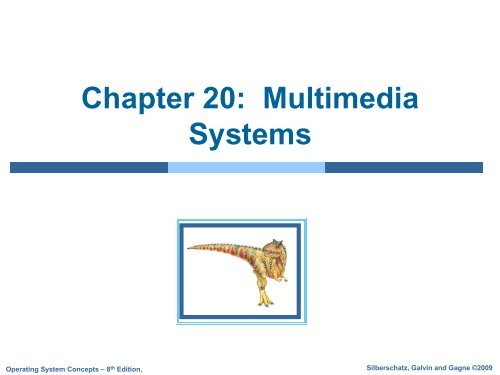

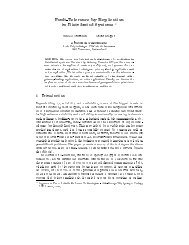
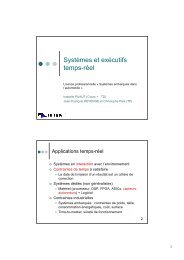






![Lecture 11 [1in] NuSMV: Model checking in practice](https://img.yumpu.com/29970359/1/190x143/lecture-11-1in-nusmv-model-checking-in-practice.jpg?quality=85)

